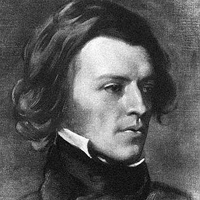The Eagle: Fragment by Alfred Lord Tennyson: Summary and Analysis
The Eagle by Alfred Lord Tennyson was first published in 1851. This very short poem is regarded as the perfect illustration of the combination of sound and meaning. Written in triplets, in just six lines, the great poet achieves success in describing the majestic scene of an eagle diving from the cliff. Though the poem is short and open ended, it is loaded with deeper meaning and different possibilities of interpretations.

Alfred L. Tennyson (1809-1892)
In the first three line stanzas, the speaker describes the position and setting of the mighty eagle. The eagle firmly holds the tall cliff with his hands, which are especially designed to clasp the mountains. The day is sunny and the background is clear blue sky without any sign of clouds. From there, he can see the azure sea below him. In the next stanza, the eagle from the tall mountain notices the waves of the sea coming towards the sea shore. Suddenly, in the last line, the eagle like a thunderbolt falls down from the cliff.
The last sentence is ambiguous because of the words like ‘thunderbolt’ and ‘falls’. If we look at the word ‘thunderbolt’ we can safely interpret that the eagle falls for the prey. The power lying in the thunderbolt supports this argument. And if we look at the word ‘falls’ then it gives equally possible another meaning that the eagle might have fallen as the prey in the sea. In both perspectives, it reflects Tennyson’s attitude towards nature. For Tennyson “nature is always red in tooth and claw” that is to say nature is destructive. This idea continues and challenges romantic attitude towards nature. Both romantics and Victorian poets use nature as the background, but when romantics regard nature as the shelter, Victorian finds it reverse. Nature is the subject matter of Victorian and romantic poetry, but romantics presents nature as a healing process, whereas Victorians present nature as a cause of pain or suffering. The poem presents nature as destructive. This poem is anti-thesis to romanticism because romanticism presents nature as protector. The Eagle, implicitly, carries Tennyson’s attitude towards nature.
Unlike romanticism, Tennyson presents nature in the destructive form. The eagle which is watching from the mountain falls like the thunderbolt and the simile has few possibilities either the bird falls for the prey or it falls as prey. Either it is destroyed by the sea or it destroys the sea creatures. In both cases, nature does not appear in the protective form. This poem is the lamentation of the destructive aspect of the nature. Therefore, the tone is elegiac. If we interpret this poem in terms of the mythical allusion of Icarus then again, it dies because of the sun, the part of nature. In all cases, nature can’t be a shelter, but a destructive force.
Some people interpret the eagle as a symbol of contemporary industrial society which was bringing material prosperity, but unfortunately that industrial life is preying upon others and is being prayed by another. What we have seen as the prosperity reaching the top, that is, in fact the decay and degeneration.
Some critic is of the opinion that the poem is incomplete as the title suggest Fragment. But, the other argues that the fragment is a symbol for the eagle, who is a part of the mountain or the nature. In this sense, this poem a complete piece of art. The mountain is the whole poem and the eagle is just a part, a fragment of it. When the eagle falls down from the cliff or from the whole, a part of its identity is lost. The open ending nature of the poem leaves the reader puzzled by the question ‘what happen to the fallen eagle?’
The eagle is personified through the use of pronouns ‘he’ and ‘him’. The attempt to humanize the eagle further takes place with the words like ‘hands’ instead of claws, ‘stands’ in place of perches and ‘falls’ rather than dives. The alliterative use of the words in the first line like ‘clasps’, ‘crag’ and ‘crooked’ give a melodious tune and the importance of the bird eagle is highlighted. This technique draws the attention of the reader towards the eagle.
Related Topics
Break, Break, Break: Critical Analysis
The Lotos Eaters: Critical Analysis
Victorian Consciousness in The Lotos Eaters
Lady Clare: Summary and Analysis
Salient Features of Victorian Literature
Personification: Definition of Literary Term
Alliteration: Definition of Literary Term
Symbol: Definition of Literary Term
Alfred Lord Tennyson: Biography
 |
bachelorandmaster.com |